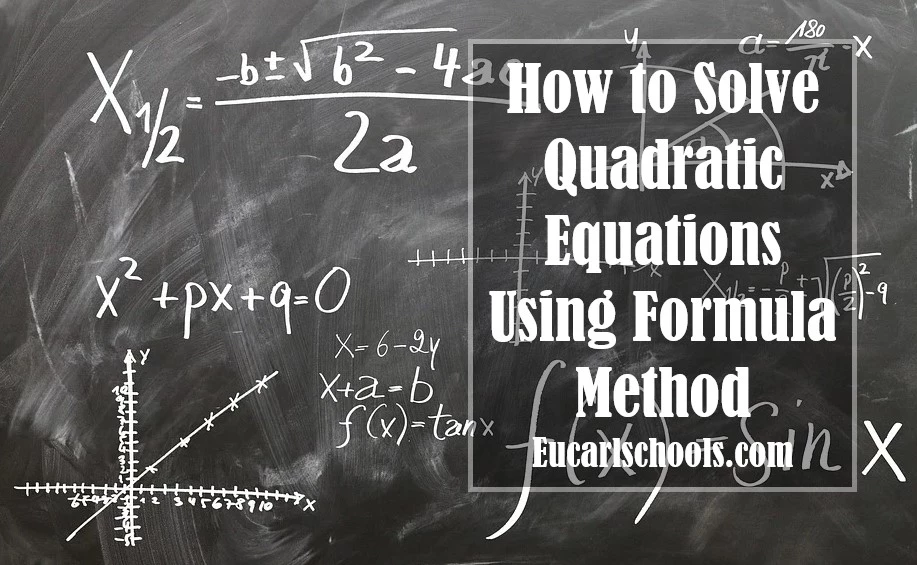How to Solve Quadratic Equations Using Formula Method
Quadratic equations are equations with the highest power of the unknown to be 2. There are four chief methods by which the unknown can be found. However, in this article, we will be focusing on How To Solve Quadratic Equations Using Formula Method.
They include
- Factorization method.
- Completing the squares method.
- Formula method.
- Graphical method.
Many times quadratic equations can not be factored out, making both the factorization method and completing the squares method redundant. This doesn’t mean that the quadratic equation doesn’t have a solution, only that just one method can be used to solve it.
That method of How to Solve Quadratic Equations is the formula method and in some places, it is known as the Almighty formula method. This aligns perfectly with the fact that there is no kind of quadratic equation this formula method can not bring up solutions.
Read Also: List of Universities & Courses that Accepts D7 [O’Level Pass]

How to Solve Quadratic Equations Using Formula Method
It is important that quadratic equations must be converted to the standard form which is most convenient whilst obtaining solutions using the formula method.
The Standard Form
The standard form implies that the quadratic expression is on the left-hand side and the number 0 is on the left with an equal side in between them. In this format, values and coefficients are not easily misplaced.
ax2 + bx + c = 0
This transformation ensures the right substitutions are made without mixing up values entirely.
The Quadratic Formula
x = -b+-√(b2 – 4ac)/2a
where a, b and c are the respective coefficients of the quadratic expression transformed to the standard form: ax2 + bx + c = 0
How to Solve Quadratic Equations with The formula might seem tedious to commit to memory, but, with constant practice, you would get used to it without forgetting any part of the formula. Competence in solving this kind of equation comes with consistently trying out such questions.
It should be noted also that this is where many students dread and end up making very silly mistakes and the result: wrong solution sets. This can be avoided it must be said. Caution must be employed at this stage.
Examples of Questions Involving Quadratic Equations Demanding The Use of Formula Method
Example 1:
Using the formula method, solve the equation:
x2 + 5x -14 = 0
The very first thing to do would be to ensure that the equation is in the standard expression format. If yes, then, one should proceed to derive the coefficients so that they could be substituted as the formula states.
It would not be a bad idea if we remind ourselves what this standard form is:
ax2 + bx + c = 0
For the question above, the equation is in the standard form, but, more often than not, it many time isn’t.
Next, up we would need to identify the respective values of a, b and c.
From our question,
a = 1
b = 5
c = -14
Remember our formula,
x = [-b+-√(b2 – 4ac)]/2a
Let us then substitute accordingly.
x = -5 +-√[52 -(41-14)]/2*1
x = -5 +-√25 -(-56)/2
x = -5 +-√(25+56)/2
x = -5 +-√81/2
x = -5 +- 9/2
x = -5 – 9/2 or x = -5 + 9/2
x = -14/2 or x = 4/2
x = -7 or x = 2
Normally, quadratic equations have two solutions most of the time. Many times there can be two possible solution sets. Besides, the unknown does not have to be compulsorily the whole number, they can be in decimals.
Example 2
Find the unknown in the quadratic equation:
2x2 + 3x = 14
With a quick look you would recognize the expression is not in the standard format:
ax2 + bx + c = 0
To transform this particular equation to the standard form, we would simply take 14 to the left-hand side.
And it will look like:
2x2 + 3x – 14 = 0
Now we have ensured it is in the standard form, let us identify our a, b, and c values.
a = 2
b = 3
c = -14
Let us then pull up our almighty formula and do the substitutions:
x = [-b+-√(b2 – 4ac)]/2a
x = -3 +-√[(32 – 42-14)]/2*2
x = -3 +- √ 9 – (-112)/4
x = -3 +- √9 + 112/4
x = -3 +- √121/4
x = -3 +- 11/4
x = -3 +11/4 or x = -3 – 11/4
x = 8/4 or x = -14/4
x = 2 or x = -3.5
There we go, we have two solution sets again, but this time one of the solutions is not only negative but also in a decimal form.
Read Also: List Of Courses That Doesn’t Require Mathematics In Nigeria
Conclusion
Generally, quadratic equations are quite easier to solve with the formula method compared to the other three methods.

![Finding The Slope of Horizontal And Vertical Lines [With Solved Examples] Finding The Slope of Horizontal And Vertical Lines [With Solved Examples]](https://eucarlschools.com/wp-content/uploads/2022/07/ezgif.com-gif-maker-1-768x457.webp)
